One Last Kiss
Powerpoint Presentation
This is a very cute powerpoint presentation with beautiful photos. Sit back and enjoy the show!
Powerpoint Presentation
This is a very cute powerpoint presentation with beautiful photos. Sit back and enjoy the show!
 |
| TruFocal eyeglasses from Zoom Focus Eyewear. (Zoom Focus Eyewear) |
For many people past the age of 40, focusing on close objects restaurant menus, — for instance — just gets harder and harder.
| More from WSJ.com: • Paper-Thin Screens With a Twist • A Genetic Test for Prospective Parents • Cash Prizes for Innovation Are Surging |
Most people with this condition, called presbyopia, eventually give in and get reading glasses, bifocals or glasses with progressive lenses.
But what if there were another alternative that didn't require people to carry an extra set of glasses or have only part of their field of vision in focus at any one time?
Zoom Focus Eyewear LLC, of Van Nuys, Calif., has just such an option, and with it won this year's Silver Innovation Award. The solution: eyeglasses, called TruFocals, that the wearer can manually adjust to give clear, undistorted vision whether reading a book, working on a computer or looking into the distance.
The judges praised the potential large-scale benefit of TruFocals. Richard S. Lang, one of the judges and a physician at the Cleveland Clinic, called the technology a paradigm shift in the way it addresses a problem "that has been handled the same way for many years."
Mimicking the Eye
For more than 100 years, researchers have tried to come up with adjustable eyeglasses; a Baltimore inventor filed a patent on the idea in 1866. But a workable product that's easy to adjust, thin, lightweight and accurate proved elusive.
Stephen Kurtin, a California inventor who previously devised one of the first word-processing programs, turned to the problem in the early 1990s. His solution, TruFocal eyeglasses, mimic the way that the lens of the human eye stretches and contracts to adjust focus.
Each TruFocal lens is actually a set of two lenses: an outer lens, and an inner lens made of a flat glass plate attached to a flexible membrane that contains a clear, silicone-based liquid. A manual slider on the bridge of the eyeglasses adjusts the focus by changing the shape of the membrane. The outer lens can be custom made to correct other vision problems besides presbyopia, including nearsightedness and astigmatism.
Once the TruFocal lenses are adjusted, the entire field of vision is in focus, unlike bifocals and progressive lenses, which keep only a limited area in sharp focus. So a user can adjust the glasses to focus only on the book he's reading, then look up and readjust them to focus solely on the TV across the room.
One Shape, Several Colors
There were some false starts along the way. Mr. Kurtin considered using liquid-crystal electronics to adjust the focus, but the batteries proved problematic. The first model weighed seven pounds. But after nearly 20 years of refinements, the first TruFocal glasses were introduced in 2009.
There's a downside for the fashion conscious: The glasses come in one shape — round — and have been compared to the spectacles worn by Harry Potter. (They are sold in several colors, though.) The circular lenses are necessary to the workings of the technology; with any other shape, the flexible membrane couldn't keep a spherical shape when compressed.
TruFocals aren't the only glasses with adjustable lenses. But other products are mainly designed for users in the developing world, where optometrists aren't widely available; they are meant to be adjusted once by the user to correct the focus at a given distance and then set that way. The Zoom Focus product is aimed at wearers who want to make constant adjustments in their vision.
Next month, TruFocals will be rebranded as Superfocus glasses. The company will also change its name, to Superfocus LLC.
 |
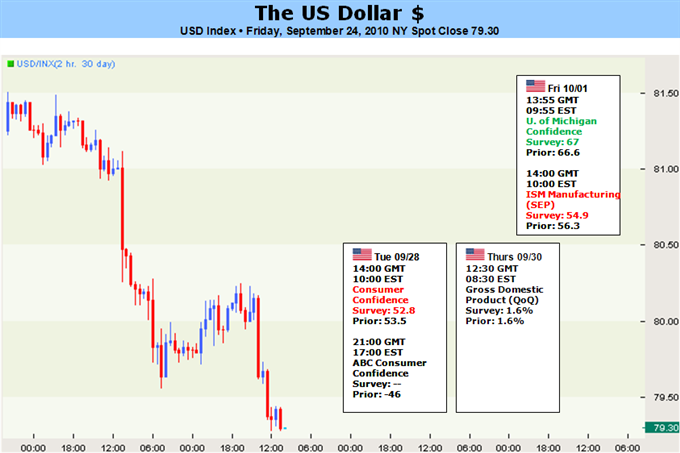
US Dollar at Risk of Declines as Fed Hints at Fresh Quantitative Easing
Fundamental Outlook for US Dollar: Bullish
The US Dollar finished sharply lower against all major forex counterparts on a week of mediocre economic data and a noteworthy shift in rhetoric from the US Federal Reserve. The highly-anticipated Federal Open Market Committee (FOMC) interest rate announcement and statement forced sharp moves across financial markets. Officials strongly suggested that they stood ready to restart Quantitative Easing (QE) measures if the need presented itself, and an especially dovish tone on inflation implied that such a move could come sooner than later. Given that the US Dollar fell precipitously on the first wave of QE, the prospect of QE Part 2 could spark continued USD weakness against major counterparts.
Market focus on the Fed’s next moves will make US economic data especially market moving, and a relatively busy calendar in the week ahead could bring sharp US Dollar volatility. Second revisions to Q2 Gross Domestic Product data may be the highlight of the coming days of trading, but traders should likewise watch for surprises out of earlier-week Consumer Confidence figures and end-of-week ISM Manufacturing data.
Market reactions will likely be linked to implications for the Fed’s next monetary policy moves. US Dollar moves on Consumer Confidence and GDP results should subsequently be straightforward; disappointments should force USD declines while positive surprises would likely see the Greenback rally. This should also roughly prove true for market reactions to ISM Manufacturing data, but any particularly large shifts in the “Prices Paid” index could blur implications for the Dollar. Consensus forecasts for all of these economic releases point to deterioration in economic conditions. Such bearish expectations leave plenty of room for positive surprises, but continued disappointments in US economic data hardly inspires confidence in prospects for the week ahead.
Short and medium-term momentum favors US Dollar declines, but the threat of sharp upward corrections grows as sentiment hits further USD-bearish extremes. Our most recent FX Options and Futures weekly report underlines the fact that many speculators are betting on further Greenback weakness. Said traders are usually in the right direction of the trend, and we have accordingly called for USD weakness. Yet traders should be careful of chasing US Dollar declines amidst high risk for corrections and monitor position risk accordingly. - DR
How far do you think the dollar will rally? Discuss the dollar’s future in the DailyFX Forum.
For more timely FX market analysis, take advantage of the DailyFX Real Time News service.
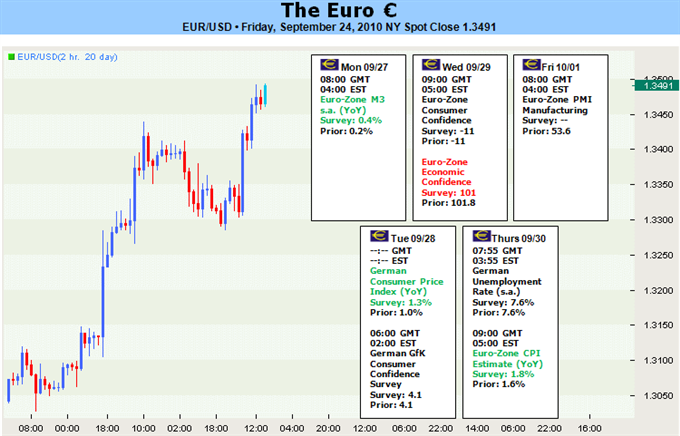
Euro Rally Increasingly Suspicious as Fundamentals Remain Anchored
Fundamental Forecast for Euro: Neutral
- European Union members continue to issue debt at exorbitant rates; but investors ignore this concern
- Germany’s IFO Business sentiment survey provides the euro temporary fundamental footing
- How far can EURUSD run? After forging four-month highs, overhead resistance has lightened up
For those that follow the macro trends behind the currency market, it is difficult to reconcile the euro’s remarkable climb to new highs with the lingering financial and economic troubles that this economy continues to face. Nonetheless, the currency managed a week-end rally against its benchmark counterpart (the US dollar) Friday to close at its highest level in five months. Now, with EURUSD standing just below the highly visible 1.3500 psychological level (and 50 percent Fibonacci retracement for you technical traders), there is a distinct bite of speculative momentum to the otherwise remarkable two-week bullish bias the market was already touting. However, traders are a flippant crowd; and considering the euro is leveraging much of its performance on the sentiment of the crowd, forging further ground when the unit is already at such extraordinary highs will carry with it exceptional level risk.
There are a few primary drivers that can sustain or undermine the euro’s performance going forward. One uncertainty that seems to have lost much of its potential influence over future price action is the financial predicament individual EU members and the region as a whole faces going forward. Though there are few scenarios going forward where the euro-region will find itself unscathed in its fight against budget deficits balanced against slowing economic activity, market participants are proving to defer to the here-and-now rather than concern themselves with what lies further down the road. This is fortunate for bulls as it diverts attention away from lingering concerns over Portugal’s lack of progress on cutting its own budget gap (the government recently upgraded its deficit assessment) and Ireland’s liability in preventing Allied Irish from sinking its entire financial system. Helping to remove an otherwise consistent threat, there are few scheduled sovereign debt sales by the most troubled EU member economies. Italy has penciled in three consecutive days of auctions and Spain is on the books for one.
If we want to ascertain the euro’s bearing and pace, the best place to look is the dollar. Or, more specifically, we should be looking at EURUSD. Though the shared currency has shown significant progress against many of its counterparts (positive sentiment arguably helps this particular currency the most because investor concern was the cause of its deterioration), a considerable share of its strength can be ascribed to the outflow of capital from the greenback. Investors are moving out of the dollar (or more precisely Treasuries and other dollar-based assets) for fear that the extraordinarily loose monetary policies the Fed has adopted will devalue the nation’s assets. For bulk investment funds and reserve assets, liquidity is essential. Naturally EURUSD being the most liquid currency pair and considering Europe maintains one of the most open markets in the world, it is a natural destination for capital.
As for scheduled event risk, the docket is loaded with notable market-movers and subtle backdrop performers. If we are looking for short-term volatility, the German GfK consumer confidence survey, CPI and unemployment change figures all have a level of prestige. If we want to follow long-term trends, we will look to the M3 figure as an objective inflation gauge and EZ sentiment readings for growth potential. - JK
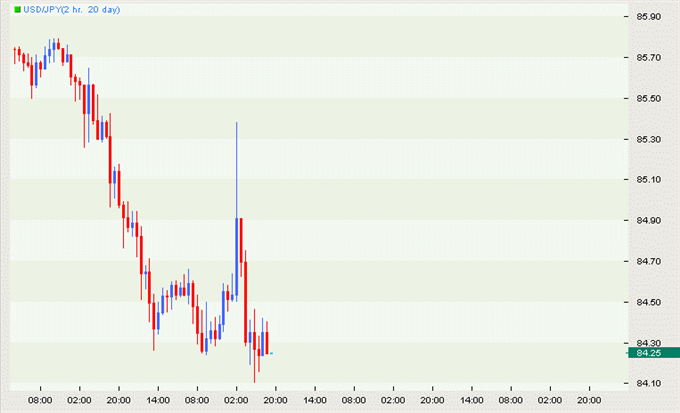
Japanese Yen Could Strengthen On Safety Flows Despite Active BoJ
Fundamental Forecast for Japanese Yen: Neutral
Reported BoJ intervention during Friday’s Asian session generated a brief bout of across the board yen weakness, but the move was quickly retraced as cautious markets were favoring safety. The Asian currency would ultimately lose ground against several counterparts, as a positive U.S. durable goods orders report generated broad based risk appetite. A disappointing U.S. new home sales report would add to the prevailing outlook for additional QE from the Fed, the potential for additional stimulus only added to support for equity markets, and succeeding where the central bank failed. However, the dollar continued to be punished by the prospect of FOMC purchases, causing it to remain flat on the day against the Yen.
The Yen’s strength against the dollar has raised concerns amongst policy makers with Governor Masaaki Shirakawa stating in an interview that the central bank needs to monitor risks to Japan’s economy, exports, and corporate profitability. Board member Ryuzo Miyao also expressed concerns in a speech stating that “We’re entering a situation where we need to pay more attention to downside risks.” He would also acknowledge that the buying of Japanese Government bonds is one policy action that the central bank will consider at their next meeting. It could be an interesting meeting considering the recent activity of the central bank, especially since today’s Yen weakness has also been attributed to the possible resignation of Governor Masaaki Shirakawa. The monetary authority head is scheduled to speak on September 25th and 27th which could present event risk for the yen if he sheds light on his status, intervention or QE.
Continued risk appetite could be the best case scenario for policy makers as it will lead to flows out of the safe haven currency as traders look for higher yields. However, the potential for growth concerns to re-emerge is high considering central banks are beginning to lean toward additional stimulus. The fundamental calendar is full of key gauges that will provide insight into the economy, despite their lack of market moving potential. The prospect of action from the central bank may give additional weight especially the CPI report. Signs that deflationary pressure are growing could force the central bank’s hand, especially if the Tankan readings point toward slower activity. Early forecasts are for consumer prices to remain unchanged at -0.9% with manufacturers becoming more optimistic. A lower jobless rate, higher retail trade, plus improvements in industrial production and housing starts are expected. If a rosier growth picture emerges, then the monetary authority could stay on the sidelines, leaving the yen at the mercy of broader trends. -JR
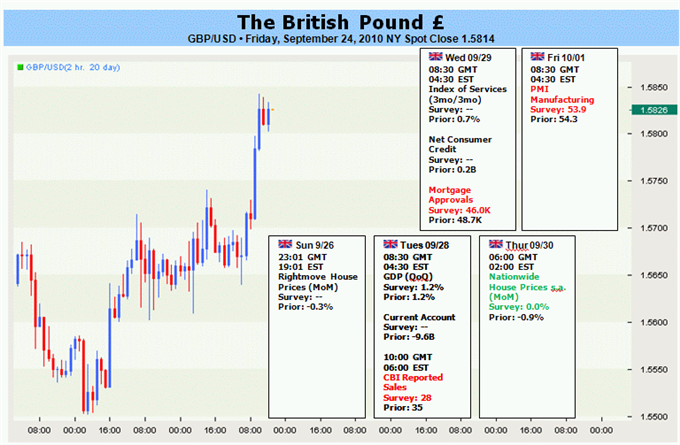
British Pound Rally Could Falter As Economic Outlook Deteriorates
\ Fundamental Forecast for British Pound: Neutral
The British Pound advanced to a fresh monthly high of 1.5815 on Friday and the exchange rate may continue to trend higher going into October as it breaks out of a narrow range. The GBP/USD cleared the 38.2% Fibonacci retracement from the 2009 low to high around 1.5700, and the pound-dollar may work its way back towards 1.6000 as it pares the decline from August. However, as the economic docket is expected to reinforce a weakening outlook for the region, the developments could curtail the recent strength in the sterling as investors weigh the prospects for a sustainable recovery in the U.K.
The final 2Q GDP reading for the U.K. is expected to show the economy expanding at an annualized rate of 1.7%, while total business investments is projected to contract 1.6% from the first three-months of the year. In addition, separate reports by the Bank of England are anticipated to show a GBP 2.9B decline in housing equity withdrawals, while mortgage approvals are forecasted to increase 47.0K in August after expanding 48.7K in the previous month. The data could spark a bearish reaction in the British Pound as growth prospects deteriorate, and an unexpectedly downward revision in the growth report or a smaller-than-anticipated rise in mortgage lending could stoke a reversal in the GBP/USD. If we see a retracement unfold over the following week, we would expect an initial test of the 38.2% Fib at 1.5700, but a sharp decline could lead the exchange rate to fall back towards the lower bound of its recent range around 1.5300.
Nevertheless, members of the BoE may change their tone towards future policy as inflation continues to hold above the government’s 3% limit for inflation, and hawkish comments from U.K. policy makers could stoke a rise in interest rate expectations over the coming months. MPC board member Andrew Sentence argued the central bank should gradually normalize monetary policy “soon” as the recovery takes hold, while his former colleague Kate Barker said the scope to increase quantitative easing looks “less certain” given the stickiness price growth. As the risks for inflation become an increased concern, members of the MPC may heed to Mr. Sentence’s call in order to give the central bank increased flexibility in managing monetary policy over the medium-term. - DS
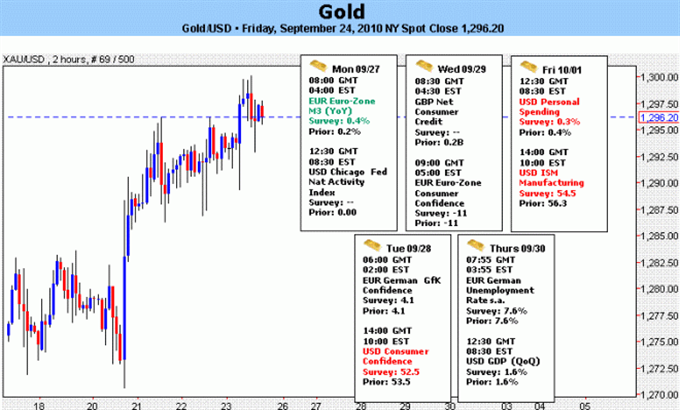
Fundamental Forecast for Gold: Bullish
Gold prices continued to edge higher last week, touching a new record high of $1300 in Friday’s trade. The yellow metal seems to reflect the shaky climate prevailing across financial markets more than any other trading instrument. Indeed, short-term correlation studies show only tenuous links between gold and most other benchmark assets as investors bank on its store-of-value properties amid continued uncertainty about global growth and inflation trends. In fact, gold ETF holdings rose to a record-high 67.2 million ounces last week.
Looking ahead, next week’s economic calendar promises plenty of scheduled event risk to keep markets engaged in the debate about the depth of the likely slowdown on tap in the second half of the year and its implications for the recovery at large. US releases remain of central concern as the health of the world’s largest consumer market remains a proxy for worldwide performance. The final revision of second-quarter GDP figures is expected to confirm previous estimates of a 1.6 percent annualized increase in the three months through June, but timelier indicators offer a mixed picture. Personal Income is set to tick higher for the second month while Personal Spending matches the largest increase in four months in August. However, it’s tough to feel sanguine about such results considering Consumer Confidence is due to decline in September having advanced in the preceding month, hinting the gains in income and spending may not prove lasting. On balance, September’s ISM outcome may prove to define the trading week, with the report set to show US manufacturing growth has faded to the slowest pace in 10 months.
Beyond the States, the Tankan Survey of sentiment among Japan’s export-sensitive manufacturers will offer a reading on the vitality of global demand, with expectations pointing to relative optimism on the forward-looking Outlook gauge and a continued acceleration in capital expenditures. China’s Manufacturing PMI will serve much the same purpose, with forecasts calling for the pace of industrial-sector growth to rise for the second consecutive month in September. While seemingly encouraging, these outcomes may not prove to meaningfully underpin optimism considering the murky US economic landscape coupled with signs of European slowdown evidenced the last batch of PMI figures and the steady slide in the Baltic Dry Index – a measure of international trade activity – which finished last week at the lowest in over a month.
On balance, it seems the path of least resistance points toward a continuation of gold’s gradual ascent, with conflicting economic data flow seemingly assuring steady investment demand as markets remain wanting of trend-defining clarity on the medium-term path of global growth.
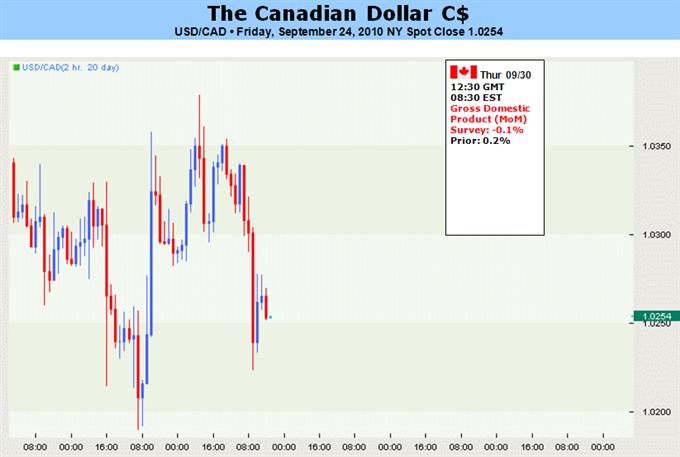
Canadian Dollar Underperforms and Outlook Remains Bearish
Fundamental Forecast for Canadian Dollar: Bearish
- Canadian Retail Sales disappoint markets
- Technical studies suggest Canadian Dollar may lose further
Pronounced US Dollar weakness meant that the Canadian Dollar finished the week higher against its namesake, but the Canadian currency underperformed all other G10 counterparts and relative weakness suggests risks remain to the downside in the week ahead. Relative disappointments in Canadian Retail Sales and Consumer Price Index data affected market expectations for the future of domestic interest rates. Overnight Index Swaps now price in a 20 percent probability that the Bank of Canada will raise interest rates at their next meeting—down from a 50 percent chance at the end of last week. Bearish US Dollar momentum suggests that the USDCAD could fall further, but the Canadian Dollar’s inability to capitalize on Greenback weakness raises risks of upward correction in the USDCAD.
A relatively empty week of Canadian economic event risk means that the USDCAD will likely trade off of US economic developments and moves in very highly correlated Oil prices. A potential exception comes in the form of monthly Canadian Gross Domestic Product data due the morning of the 30th. Though the month-on-month GDP figures are not known to move currencies, recent focus on Canada’s economic fundamentals may make any surprises market-moving. On the US economic docket, a slew of end-of-month economic data could potentially alter forecasts for US growth and affect financial markets.
The Canadian Dollar previously rallied against the Greenback and other major currencies on evidence that it was decoupling from a slowed US economy and showed solid growth prospects. Yet more recent economic data reminded markets that Canada remains fairly sensitive to economic developments in its southern neighbor. Disappointments in US economic data would likely force the USDCAD lower, but any especially strong surprises would likely mean that the Canadian Dollar could continue underperforming against other major counterparts.
As it stands, it is difficult to call for substantial US Dollar recovery against any major currency. Yet the Canadian Dollar may continue to underperform more broadly as markets digest a relative slowdown in Canadian economic recovery. Such underperformance would likely mean that the USDCAD continues to trade in a wide range through the foreseeable future. - DR

Australian Dollar: Trends Higher But a Reversal May Be On the HorizonFundamental Outlook for US Dollar: Neutral
The Australian dollar has rallied against the U.S. dollar this week, climbing some 2.36 percent, and finishing as the sixth best performing G-10 currency through Friday’s close. The economic docket in Australia was relatively light this week but the RBA’s minutes from September suggests that policy makers may hike rates twenty five basis points at its next rate decision meeting on October 4th. At the same time, the single currency is benefiting from a change in sentiment as concerns of another downturn in the global economy fade (for now).
The minutes from the Reserve Bank of Australia this past week showed an aggressive stance towards further tightening by the central bank. The RBA stated that they see slightly stronger domestic conditions versus the previous month, and went onto add that higher rates are likely if growth trends continues its course. The increase in borrowing costs will ensure that inflation remains consistent the bank’s target, RBA said. In turn, the Aussie rallied against the struggling U.S. dollar as traders’ priced in an increased chance that policy makers will raise its key overnight lending rate next month. According to the Credit Suisse overnight index swaps, traders believe that there is a 60 percent chance of a rate hike to 4.75 percent from its current level of 4.50 percent. It is also important to look at the Sino-Australian relations due to the fact that China is Australia’s largest trading partner because of China’s demand for iron ore, natural gas, and coal. Though China is not ready to tighten policy, the economy looks to be heading the right direction as growth continues to be supported by its exports market, which has climbed 34.4 percent in August. However, disappointing Chinese PMI manufacturing and leading index reports may weigh on the Yuan in addition to the Aussie. Strength in the Australian dollar is not solely due its domestic strength, but is also attributed to optimism in the global economy as fears of a double dip recession dissipate.
Taking a look at price action, the AUDUSD has rallied to the highest level since 2008. In turn, the exchange rate continues to trade in overbought territory, which is indicative of a correction to the downside. However, traders should not overlook a period of consolidation followed by another rally as recent developments points to additional gains. For example, my user defined the Parabolic SAR crossover signaled for an advancement in the pair on September 1st, and has yet to reverse course, while our speculative sentiment index now stands at -3.7, pointing to further increases in the pair. - MW
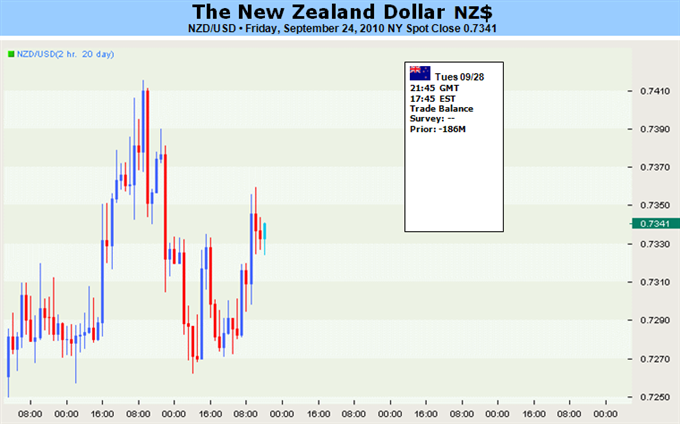
New Zealand Dollar Unable to Join Rally as Rates, Growth Dim
Fundamental Forecast for New Zealand Dollar: Bearish
Risk appetite was ramped up this past week; and many assets capitalized on the improved sentiment. However, there was a distinct performance difference between those assets that rallied in the face of fundamental concerns and those that are natural optimism bedfellows due to their investment status. The former crowd marked true breakouts and showed an effort to jump start new trends while the latter struggled to extend their performance. The kiwi dollar has its feet in both pool; but that doesn’t mean the currency comes out with a net benefit. Against the worst performing unit though the period (the US dollar), the commodity currency has found itself walled in by 0.74 resistance. Heading into the new weeks, speculative interests have already passed the breakout phase and are now going to have to stir up momentum. Will the New Zealand unit find enough of a risk current to carry it to its own rally?
First and foremost, the concern for the kiwi is the intensity of risk trends. The remarkable breakout from the S&P 500 and EURUSD was perhaps the best catalyst the broader FX market could have asked for in terms of speculative leverage. Missing the opportunity to produce a critical break on NZDUSD through this momentum is a significant oversight. From here, speculative interest will be responsible for carrying optimism to new heights; and considering there are few legitimate sources for positive sentiment, the conviction that does develop will lack. Furthermore, we see that the relatively high-yield currency is sliding fast against the fundamentally-unstable euro, the pound and even the low-yield Japanese yen. If there isn’t a spark of demand from one of this pairs, there certainly won’t be a wave of kiwi buying across the broader market.
Another interesting assessment of the kiwi can be made in its comparison to the Aussie dollar. Both are investment currencies; but we have seen the RBA maintain a hawkish bias whereas the RBNZ this past week threw the breaks on its hawkish commentary. Furthermore, growth in Australia is still running at a robust pace as the gas station to China while New Zealand has seen its growth pace slashed. Yield isn’t the only concern for the markets at this point. The demand is for those investments that can produce the highest yield or have the greatest potential for appreciating from depressed levels. Why establish a yield position with the kiwi when the Aussie is more stable and maintains a higher yield? And, why go long the New Zealand dollar when it is already at marked highs and currencies like the euro are still significantly depressed. In the absence of overwhelming momentum for yield and risk, the kiwi may flounder. - JK
EURUSD: Euro US Dollar Exchange Rate Forecast
USDJPY: US Dollar Japanese Yen Exchange Rate Forecast
GBPUSD: British Pound US Dollar Exchange Rate Forecast
USDCHF: US Dollar Swiss Franc Exchange Rate Forecast
USDCAD: US Dollar Canadian Dollar Exchange Rate Forecast